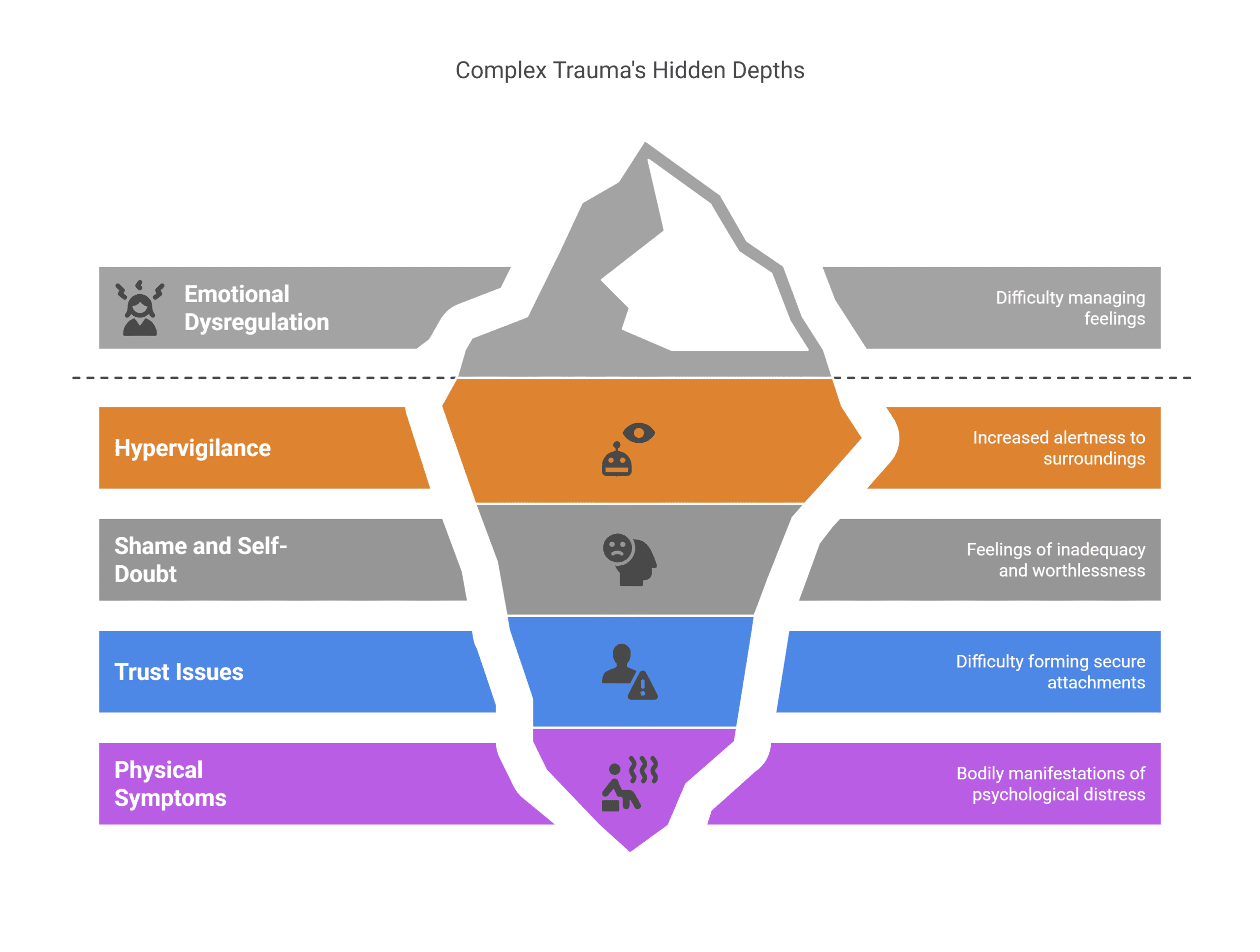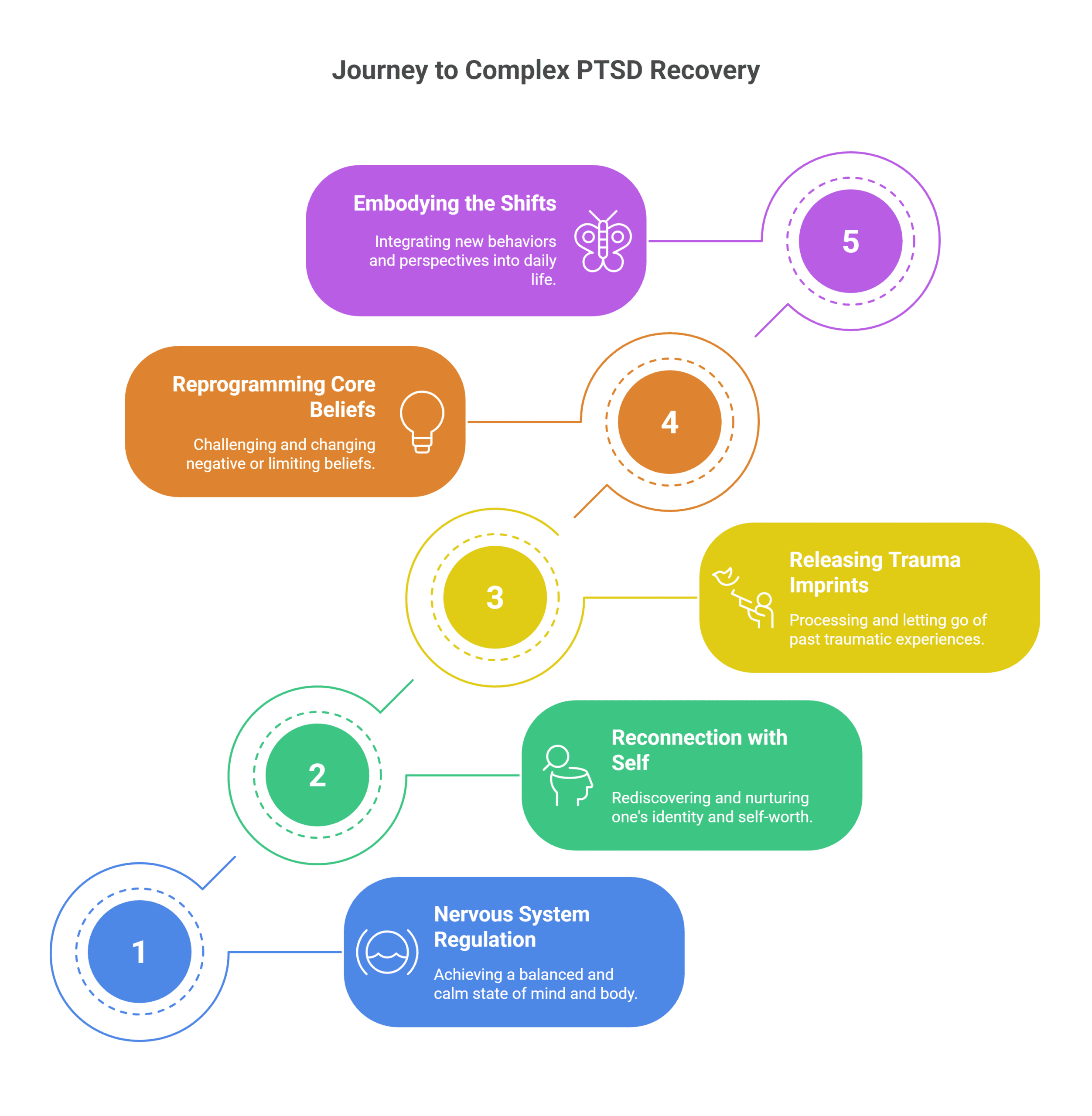Quick Takeaways
- Traditional talk therapy can fail for this type of PTSD because trauma settles in the nervous system and subconscious.
- Trauma-informed, nervous system-focused approaches can heal you truly.
- Hypnotherapy and Havening techniques provide efficient healing because they resolve trauma at its core i.e. subconscious and nervous system. Professional women, healthcare workers, and childhood trauma survivors benefit greatly from these holistic treatment.
You have shown exceptional strength in facing life’s challenges. What’s more, you have dedicated much time and energy to heal through therapy, books, and affirmations. Still, you feel a persistent weight on your mind and body. You may still feel tense during important meetings or whenever someone raises their voice. Do you feel “stuck” or “different” inside while being successful outward?
There is a solution. Complex PTSD affects many resilient people like you. This doesn’t mean you are broken. It means your mind and body are ready for a more effective healing journey.
This blog will highlight complex PTSD treatment that help you feel safe and truly free.
What Is Complex PTSD? (And Why It Is Different)
Complex PTSD (C-PTSD) is very different from standard PTSD. Both have unique roots and presentations.
Traditional PTSD begins from a single traumatic event. On the contrary, complex PTSD treatment manages long-term trauma because of repeated hurtful events. It happens in childhood mostly.
The distinguishing features of C-PTSD include:
The Trauma Origins
C-PTSD isn’t caused by a single traumatic incident—it’s the result of ongoing emotional wounds that were never given space to heal. Unlike PTSD, which often stems from one acute event like a car accident or natural disaster, Complex PTSD develops slowly over time. It’s rooted in repeated or prolonged exposure to relational trauma, especially during childhood.
This kind of trauma is often quiet, invisible to others, and deeply confusing to the person experiencing it. It comes from the very relationships that were supposed to offer love, safety, and emotional nourishment—parents and caregivers. When a child grows up in an environment of emotional neglect, chronic criticism, unpredictable outbursts, or conditional affection, the nervous system learns to stay in survival mode. Over time, this shapes how a person sees themselves, relates to others, and processes emotion.
Common symptoms of C-PTSD include:
- A persistent sense of shame or unworthiness
- Emotional flashbacks without a clear cause
- Hypervigilance or being constantly “on edge”
- Difficulty trusting others—or even trusting your own decisions
- Feeling numb, empty, or disconnected from your true self
What makes C-PTSD more complex is that there often isn’t a single event to point to. Instead, it’s the accumulation of small moments when core emotional needs—like being seen, soothed, and supported—were unmet. These unhealed wounds become subconscious patterns that silently shape adult life, relationships, and even career confidence.
But the good news is: healing is absolutely possible. Once the nervous system is given a safe space, and the subconscious mind is gently guided to process those emotional imprints, transformation can happen.
For example: Client M. is a professional. Nonetheless, she became very anxious during performance reviews. Why? The emotional neglect she went through in childhood manifested as trust issues. So, she had difficulty trusting herself, accepting praise even though she was obviously competent.
Symptoms Beyond Flashbacks
Complex PTSD treatment helps you dealing with:
- Chronic shame
- Identity fragmentation
- Hypervigilance
- Emotional dysregulation
Research shows that people with C-PTSD have more difficulty processing emotional regulation and interpersonal relationships.
For example: A successful entrepreneur, L., had trust issues in romantic relationships even though she was an efficient businessperson. Her complex trauma history made her hypervigilant and wary of showing vulnerability and emotional intimacy.
Identity and Self-Worth Issues
This disorder can distort your self-image severely. You might struggle with:
- feelings worthless
- maintaining healthy boundaries
- feeling disconnected from your authentic self
For example: Dr. J was a high-performing medical professional—but behind his calm exterior was a nervous system stuck in survival mode. He had grown up with authoritarian parents where emotional expression was unsafe, and later endured years of high-pressure, emotionally invalidating environments at work. Over time, his brain learned to cope by shutting down emotionally. While his professional composure remained impeccable, at home he often felt numb, detached, and unable to truly connect.
In Dr. J’s case, the subconscious mind had coded emotional vulnerability as dangerous. So, even when he was safe, his system kept him emotionally shut down—just to survive. This is exactly what unresolved trauma does: it trains the brain to suppress feelings in order to avoid re-experiencing past pain.
Dr. Gabor Maté explains:
“Trauma isn’t what happens to you—it’s what happens inside you when there’s no one safe to process it with.”

Why Standard Talk Therapy Often Falls Short?
Standard talk therapy often falls short because it barely scratches the surface. People may spend years in these therapies only to get limited results.
Why? Largely because of the trauma itself.
Talk therapy targets the logical, conscious mind. It mainly works on:
- Verbal processing
- Logical understanding
- Conscious insight
However, trauma is not stored in the rational brain i.e. hippocampus (responsible for memory and context). Instead, it is deep rooted in your nervous system and the limbic system which is also called “the emotional brain.”
For example: Client M. could analyse his authoritarian father’s dampening influence on his leadership style. M still felt anxious during board meetings after having some counselling sessions. This affected his career growth negatively.
You May Feel Lost
Talk therapy can help you gain insight into your trauma—at least to some extent. You may begin to understand, on a cognitive level, how your childhood, past relationships, or stressful experiences shaped your current emotional responses.
But for many people, knowing isn’t enough to feel better. Your emotions don’t stop overwhelming you. That’s because trauma isn’t just stored in your thoughts—it lives in your body, your nervous system, and your subconscious mind. You may know why you’re anxious, or why you overreact to certain triggers, yet still find yourself repeating the same patterns.
Your rational brain may figure out that the past was not your responsibility but your emotional brain never registers it. So, you may still feel:
- Afraid
- Ashamed
- Isolated
Whenever you face hurtful situations that remind you of past hurt in a deeper level.
This disconnect between conscious understanding and emotional upheaval can force you into “therapy fatigue.”
Clients become exhausted discussing their past without being able to resolve their emotions. What’s more, exposure-based therapies might even re-traumatise you. That’s why complex PTSD treatment must happen within a safe, body-centered framework.
For example: A doctor who visited us spent three years in traditional CBT talking about her workplace trauma. Nevertheless, she still had panic attacks during night shifts even after she understood the connection between patient deaths and her hypervigilance.
Client Quote: “I knew my past wasn’t my fault. But I still felt broken, like something inside me was fundamentally flawed, no matter how much I talked about it.”
The limitation isn’t in your capacity to heal. It is in those therapies that don’t target the place where trauma actually lives—your nervous system and subconscious mind.
What Actually Heals Deeply—A Somatic and Subconscious Approach
Effective complex PTSD treatment relates to your nervous system and the subconscious mind. There are two modalities that reach beyond the conscious mind to heal you completely: Hypnotherapy and Havening techniques.
Hypnotherapy for Complex PTSD
Hypnotherapy helps you access and work with your subconscious mind directly. It is very advantageous because C-PTSD distorts your core beliefs and it formed emotional imprints that caused trauma responses.
All these is stored in the subconscious mind so you can recognise and resolve them with hypnotherapy. This approach benefits you on:
- Direct Subconscious Access: It jumps over your intellectual defenses to reach the root of trauma release. Your symptoms may decrease and your negative subconscious thoughts turn positive.
A meta-analysis found that hypnotherapy shows large effect sizes for PTSD treatment. It also with sustains benefits for long term.
- Safe Emotional Reconnection: Hypnotherapy creates a safe space so you feel safe to process unhealed trauma.
It uses powerful techniques like guided imagery and regression to help you process emotions. You can especially resolve the emotions that you couldn’t really feel at the time of original trauma.
- Inner Child Healing: The unresolved needs of love and care in the childhood can develop C-PTSD symptoms.
Hypnotherapy helps you nurture and heal your inner injured child. This can resolve shame and abandonment fears.
- Reprogramming Self-Worth: Hypnosis relaxes you deeply. This state can allow you to replace negative beliefs into positive ones. As a result, your damaged sense of self worth can become whole.
For example:
Client J. endured emotional neglect in childhood. It manifested as chronic people-pleasing and inability to say “no” to create healthy boundaries. This created issues in her healthcare leadership role.
Hypnotherapy helped her access suppressed childhood emotions to build healthy assertiveness skills. As a result, she was finally able to get a promotion while maintaining work-life balance.
💬 Therapist Insight: “One client described it as ‘the first time I felt safe going back to the past because I knew I would not relive it but rewrite it.’”
Havening Techniques
Havening techniques combine gentle self-touch with memory rewiring. These are powerful methods that might heal your trauma permanently.
- Neurobiological Healing: Research shows that Havening reduces amygdala activation. In turn, it strengthens the hippocampus and prefrontal cortex. Since trauma is closely related to amygdala, this power shift builds your emotional regulation.
- Empowerment Through Self-Application: You can feel in charge because you can learn to perform it on yourself. So, you can get a powerful tool for managing emotional overwhelm as soon as it starts.
- Gentle and Non-Invasive: Havening uses simple touch with eye movements and visualisation to process trauma. You don’t have to discuss traumatic details again and again. This approach is good in complex PTSD treatment if you were re-triggered in talk therapy sessions.
- Rapid Results: You may notice positive changes within just a few sessions. This happens because of the delta waves that generate in your brain when you do the Havening Touch.

Client S.’s Journey From Stuck to Safe
Sarah (name changed for privacy) had spent eight years in and out of traditional therapy before she visited us. She was very intellectually aware of how her trauma started. Nevertheless, she still shut down during minor arguments at workplace.
Limitations
Sarah had very authoritative parents. Their extremely strict manner made her stuck in chronic hypervigilance and shame. Although she became a successful business professional, she still struggled with:
- Perfectionism
- People-pleasing
- Inability to set boundaries
MIHH’s Intervention
We combined hypnotherapy and havening techniques to help her face and resolve traumatic memories.
Hypnosis helped her to reconnect with her younger self. She regained the compassion and validation she hadn’t gotten in her early years.
Havening helped her nervous system release stored trauma. It also developed new neural pathways that made her feel safe.
Results
The transformation was gradual. Sarah noticed her body felt calmer after a few sessions. She could speak up in meetings without her heart racing.
Also, she could respond to triggering events with a clear mind rather than getting overwhelmed.
She declared: “I don’t just survive my triggers now. I react with clarity. I finally feel like myself.”
The Science of Deep Healing
The neuroscience behind trauma helps explain why some treatment methods fail and others succeed. Approaches that target your brain’s capacity for neuroplasticity (forming new neural pathways) usually bring better results.
The Trauma Brain
Trauma influences three brain areas:
- The amygdala (fear center) becomes hyperactive as it is always anticipating threats.
- The hippocampus (memory center) cannot store and process traumatic experiences properly.
- The prefrontal cortex (higher function) shuts down in triggering situations.
Nervous System Dysregulation
Research shows that trauma can disconnect the nervous system and body. So, you may get stuck in fight-flight-freeze reactions forever. Conventional talk therapies don’t usually focus on this aspect.
Why Subconscious Rewiring Works (When Talk Therapy Doesn’t)
Unlike talk therapy, which often focuses on conscious thoughts and beliefs, these methods go deeper—accessing the subconscious mind where emotional memories and survival patterns are stored. They help rewire the brain’s faulty threat detection system, the part that keeps sounding the alarm even when you’re no longer in danger. As your brain begins to distinguish between real and perceived threat, emotional regulation becomes natural—not forced. You stop reacting from old wounds and start responding from inner safety.
Vagus Nerve Restoration
The vagus nerve pathway is often impaired in complex PTSD. This nerve signals are important for feeling safe and connected. Studies declare that body-based interventions help restore vagal tone. As a result, your emotional regulation can improve.
“They speak the language of the body—not just the brain.”
In a Nutshell
Your symptoms of complex PTSD treatment are actually your mind and body’s protective responses to life-long trauma. They once served you but have become a hindrance now. However, the right approach can make you feel safe and confident.
Are you ready to live the confident life you desire? Book a FREE strategy call with our trauma-informed therapists today. Let’s see how healing transforms you.
FAQs
What Is the Main Difference Between Complex PTSD (C-PTSD) and Standard PTSD?
Complex PTSD (C-PTSD) develops from life long trauma usually due to poor relationships in childhood. In contrast, standard PTSD usually starts from a single traumatic event. C-PTSD’s symptoms go beyond just flashbacks. They can affect identity, emotional regulation, and adulthood relationships.
Why Might Traditional Talk Therapy Not be Effective for Complex PTSD Treatment?
Traditional talk therapy focuses on the conscious mind and verbal processing. However, trauma is stored in your emotional mind. So, intellectual knowledge of how your trauma started won’t resolve your symptoms. Instead, you may feel stuck at one place for months until you develop “therapy fatigue” without true emotional resolution.
How do Hypnotherapy and Havening Techniques Help in Complex PTSD Treatment?
Both hypnotherapy and Havening techniques help you reach and work with the subconscious mind and regulating the nervous system. Your trauma is stored in these places actually. Hypnotherapy directly targets core beliefs and emotional memories.
It can reprogram your self-worth. On the other hand, Havening uses gentle touch to de-link traumatic memories from their emotional value. It means you won’t feel overwhelmed while remembering the traumatic memory. These methods calm your body and mind to provide long-term relief.








